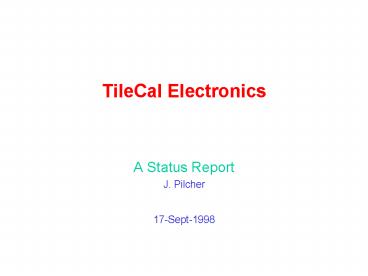TileCal Electronics - PowerPoint PPT Presentation
Title:
TileCal Electronics
Description:
A status report on the front-end and digitizing electronics ... Clamping amplifiers and drivers. Gain ratio 64:1 for dual 10-bit ADCs. 3-in-1 Card Status ... – PowerPoint PPT presentation
Number of Views:44
Avg rating:3.0/5.0
Title: TileCal Electronics
1
TileCal Electronics
- A Status Report
- J. Pilcher
- 17-Sept-1998
2
Outline
- A status report on the front-end and digitizing
electronics - Overview of requirements
- Development status
- July 98 test beam results
- Barrel module 0 equipped with 2 superdrawers
- 90 channels
- First system tests with in-drawer digitizers
3
REQUIREMENTS
- Process 10,000 PMT signals
- Located in 256 electronics drawers
- Up to 45 PMT/drawer
- Each module self-contained with own electronics
4
REQUIREMENTS
- Performance
- 16 bit dynamic range
- Up to 2 TeV in single cell
- Must see muons
- Calibration and monitoring
- Enhance muon ID
- Readout resolution should not degrade calorimeter
energy resolution - Calorimeter resolution gt 2
- Need readout resolution of a few percent in each
cell - Jet populates many channels
- averaging effects
5
REQUIREMENTS
- In situ calibration
- Gives readout conversion factor (pC/count)
- Measures linearity
- Calibrates source integrator
- Slow integrator for PMT current
- LVL1 trigger tower sums
6
ORGANIZATION
- 3-in-1 Card
- One per PMT
- Plugs into PMT anode
- Near-ideal current source
- Pulse shaped signals to digitizers
- Integrator for source calibration and monitoring
min-bias current - Gain switching
- Output gating
- Charge injection for electronics calibration
- LVL1 Trigger output
- Gated
7
ORGANIZATION
- Mother Boards
- set of 4 in tandem per drawer
- Services and control signals to 3-in-1
- Digitizer Boards
- set of 4 (or 8) per drawer
- Connections to drawer
- TTC fiber
- S-LINK fiber
- D.C. Power
- CANbus
8
3-in-1 Card Status
- Bigain pulse shaper
- 7-pole Bessel filter (purely passive)
- Exploit current source nature of PMT
- No noise, no power
- Very linear
- Clamping amplifiers and drivers
- Gain ratio 641 for dual 10-bit ADCs
9
3-in-1 Card Status
- Output pulse to digitizers
- Low Gain (1 GeV/mV)
- Full scale signal
- High Gain (16 MeV/mV)
- Muon signal
10
3-in-1 Card Status
- Linearity and calibration
- Residuals lt 1 count over full dynamic range
11
3-in-1 Card Status
- Source integrator
- Essential for Cs calibration and monitoring of
calorimeter - See preceding talk
- Cs calibration has short-term reproducibility of
0.1 - Should be matched by electronics stability
12
Integrator Readout Status
- independent readout for each drawer
- ADC board CANbus
- Multiplexed to individual 3-in-1 cards
13
Source Integrator
- Stability better than 0.1 over 2 months
(calibrator integrator)
14
Digitizer Status
- Partially equipped Barrel Module 0 (30 channels)
in July 98 - First system test of in-drawer digitizers
- Two 10-bit 40 MSPS ADCs per channel
- High gain scale 0 - 16 GeV (16 MeV/count)
- Low gain scale 0 - 1000 GeV (1 GeV/count)
- Commercial components
- TTC input on optical fiber
- 40 MHz clock, LVL1 accept, digitizer control data
15
Digitizer Status
- Pipeline delay via custom ASIC
- Digital memory unit (DMU)
- Originally developed for PHENIX TEC
- Output via optical S-LINK
- Read with optical LDC/PMC, RIO processor
16
July 98 Test Beam Results
- Laser calibration
- Measure linearity and stability of PMT and
electronics - 3 PIN diodes to monitor laser
17
July 98 Test Beam Results
- Digitized signals
- More pedestal noise on high gain channel
- Digitizing clock not synchronized to beam
18
July 98 Test Beam Results
- Pedestal Noise
- Noise for high gain branch 1.1 counts
- Corresponds to 0.4 photoelectrons in PMT (17
MeV) - SPICE simulation predicts 1.2 counts
- Noise for low gain branch 0.5 counts
- SPICE simulation of 3-in-1 card predicts 0.3
counts - Digital noise lt 0.4 counts
19
July 98 Test Beam Results
- Muon response for the 3 sampling depths (?90?)
- Pedestal superimposed
- Using signal from empty events
- Width reflects energy algorithm as well as
electronics - 10 digitizations used for each measurement (not
optimized)
- Muon signal well resolved from pedestal
20
July 98 Test Beam Results
- Electron response
- Most energy in a single cell
- Channel-to-channel intercalibration less
important - Calibration not yet available
- 50 GeV and 100 GeV electrons
21
July 98 Test Beam Results
- Use e- response to measure readout resolution
- Fit for a
- reflects readout resolution and energy algorithm
22
July 98 Test Beam Results
- Energy resolution gives readout resolution of 0.5
counts/sample - ADC quantization error ? noise ? ...
- Noise study gave 0.5 counts
- Well understood result
- Readout will not limit resolution of hadronic
calorimeter
23
July 98 Test Beam Results
- Pion energy resolution from test beam
- Under analysis
- Needs cell-to-cell intercalibration
- Electron shower largely contained in single cell
24
Future Planning
- Radiation hardness tests this fall
- Design review this fall
- Electronics PRR spring 99
- 3-in-1 production to start spring 99
- Version 2 of digitizer to be demonstrated spring
99 - Final electronics needed for module calibration
in 00, 01, 02 - Finish production of electronics in 02
- Before start of installation
25
Conclusions
- TileCal electronics shows good performance
- Achieved required dynamic range with linear
system - Very low system noise
- Electron energy resolution used to measure
readout resolution - First successful tests of in-drawer digitizers
- No unexpected problems so far
- Still a lot of work to do!
- Expect to start production on schedule































